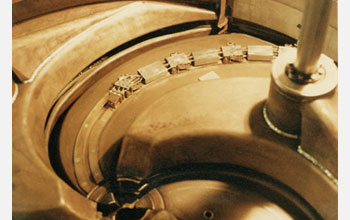|

All Images

Discovery
Nuclear Scientists Explore the Core of Existence

Back to article | Note about images
 |
Matt Johnson, staff enginer at the National Superconducting Cyclotron Laboratory (NSCL), inspects a 45-degree dipole magnet. The magnet, used to turn and separate nuclei, was installed in 2007, enabling researchers to continue pursuing exotic nuclei at the edge of existence.
Credit: NSCL |
Download the high-resolution JPG version of the image. (45 KB)
|
Use your mouse to right-click (or Ctrl-click on a Mac) the link above and choose the option that will save the file or target to your computer.
|
 |
Picture from the NSCL experimenters' logbook used by the researchers when they created three super-heavy isotopes of magnesium and aluminum. The scrawled note, "Let the celebrations begin!" reflects the researchers excitement at the discovery.
Credit: NSCL |
Download the high-resolution JPG version of the image. (96 KB)
|
Use your mouse to right-click (or Ctrl-click on a Mac) the link above and choose the option that will save the file or target to your computer.
|
 |
This is a closeup of the exposed guts of the NSCL K500 cyclotron, the world's first superconducting cyclotron.
Credit: NSCL |
Download the high-resolution JPG version of the image. (67 KB)
|
Use your mouse to right-click (or Ctrl-click on a Mac) the link above and choose the option that will save the file or target to your computer.
|
|





